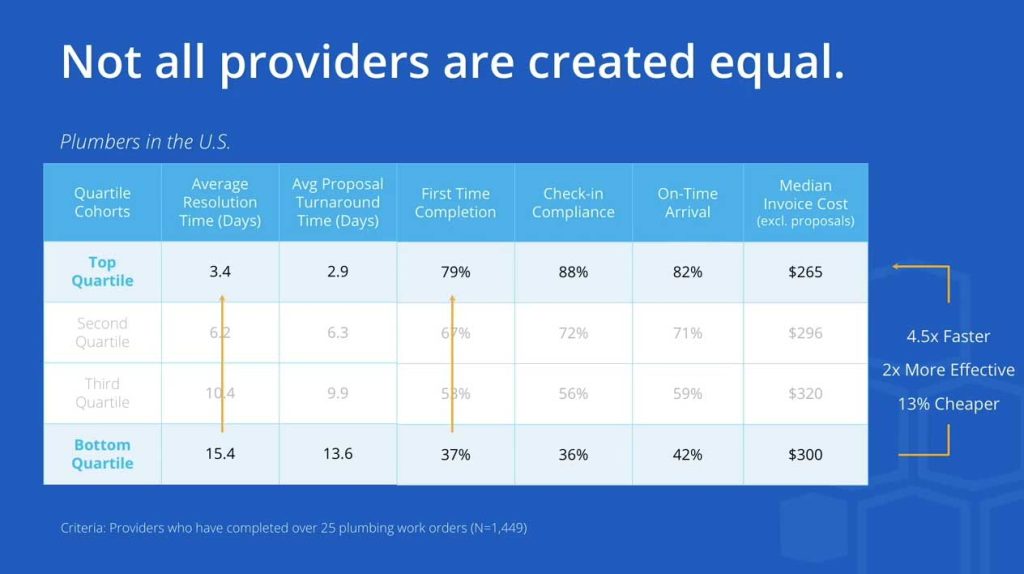How to Develop an Effective Vendor Performance Tracking Strategy

Learn how to monitor vendor performance effectively, reduce risk, and improve service quality with a data-driven strategy built for long-term success.
Tracking vendor performance is vital for making sure your service providers meet expectations, deliver consistent value, and support long-term business goals. Operations feel a near-immediate impact when vendors fall short on timelines, service quality, or cost.
A strong tracking strategy gives your team the tools to monitor provider performance in real time, resolve issues before they escalate, and maintain a positive relationship with all your vendors. In this guide, you’ll learn how to set clear measurement goals, choose the right tracking systems, evaluate vendor performance effectively, and build stronger, data-backed partnerships with providers you rely on most.
Key Elements of Vendor Performance Tracking
At its core, monitoring vendor performance supports greater clarity, consistency, and accountability for the vendor’s benefit and for your organization’s. A solid tracking strategy should include a few essential action items that will help your team stay proactive and informed:
- Clear Key Performance Indicators (KPIs): Set measurable goals for delivery times, quality, pricing, and service to give vendors a transparent standard to meet.
- Regular Vendor Performance Reviews: Schedule performance check-ins to help keep vendors on track and provide a medium for feedback and course correction.
- Service Level Agreements (SLAs): Include clear expectations in SLAs to provide your team with concrete criteria to measure against and support vendor accountability.
- Vendor Performance Monitoring Tools: Consider a reliable tracking system that can automate reporting, flag service issues, and support better decision-making through real-time performance data.
- Performance Reports: Summarize vendor performance metrics across multiple categories to compare vendor performance and identify top performers.
Each of these practices plays a critical role in managing vendor performance while supporting continuous improvement. A structured approach makes it easier to identify concerns early and make adjustments that benefit both parties.
Benefits of Effective Vendor Tracking
A methodical approach to vendor tracking unlocks a wide range of operational and strategic advantages, such as:
- Improved Vendor Relationships: Transparent expectations and regular communication help build trust and long-term alignment.
- Reduced Risk: Monitoring vendor performance helps you catch compliance issues, missed deliveries, or quality problems before they escalate.
- Cost Control: By tracking service levels and comparing pricing, you can identify cost-saving opportunities without sacrificing quality.
- Stronger Vendor Compliance: Clear documentation and consistent reviews make meeting internal standards and industry regulations easier.
- Better Decision-Making: Reliable performance data enables smarter vendor selection and more informed contract negotiations.
Each benefit reinforces the other. For example, regular reviews can improve vendor accountability and customer satisfaction. Whether your organization works with a dozen or hundreds of vendors, tracking KPIs can reveal opportunities for process improvements, reduce operational friction, and increase overall value across your service network.
How to Build Your Vendor Tracking Strategy
A well-defined performance monitoring strategy gives your team the structure and visibility it needs to manage vendor relationships effectively. It also creates a shared framework that keeps all parties focused on consistent service delivery, quality standards, and long-term business value.
1. Set Clear KPIs and Goals
Setting clear key performance indicators (KPIs) is essential to any successful vendor management strategy. These metrics define how an organization measures performance and provide an objective basis to evaluate service delivery, quality, cost, and communication.
The right KPIs will vary depending on your industry and vendor type, but common examples include on-time delivery rates, error-free work orders, cost per service call, and customer satisfaction scores. Be sure to document these expectations in vendor agreements and service-level commitments or even embed them directly into your vendor codes.
When you define KPIs up front and consistently track them, vendors know exactly what you expect, and your team has a measurable way to hold them accountable.
2. Identify Relevant Metrics
Not all vendor performance metrics carry the same weight. Focus on the measurements that matter most to your operations. This eliminates confusion, reduces service inconsistencies, and encourages stronger accountability.
First, determine performance areas that directly affect business outcomes, such as delivery times, response rates, and quality of service. These metrics should align with your organization’s priorities and reflect realistic expectations for each vendor relationship.
Make sure your team can regularly monitor and review this data. By focusing on relevant metrics, you can spend less time chasing down problems and more time building value-driven partnerships.
3. Implement Tools and Systems for Real-Time Tracking
Modern vendor management tools make it easier to collect, review, analyze, and act on performance data without adding manual overhead. A centralized platform allows your team to monitor service delivery across locations, generate vendor scorecards, and respond quickly when issues arise.
Look for solutions that offer automated alerts, customizable dashboards, and reporting features that align with your KPIs. When data flows in real time, your team will anticipate problems and catch them early. With up-to-the-moment information, your team can make decisions based on up-to-date performance insights, not outdated paperwork or incomplete reports.
The right platform turns vendor monitoring from a reactive task into a proactive process that supports continuous improvement.
4. Choose a Vendor Rating Platform
A vendor rating or evaluation system provides an objective way to compare vendor performance across key metrics. You should be able to monitor crucial criteria such as customer complaints, delivery success rates, and SLA compliance statistics. These systems help standardize vendor performance management by combining reviews, alerts, and compliance data into a single interface.
Look for tools that provide real-time updates, flexible scoring systems, and automated reporting features. This makes it easier to identify underperforming vendors, highlight top performers, and respond to service issues before they affect operations.
Many vendor evaluation systems also support service level agreement (SLA) monitoring, helping your team stay on top of expectations and improve vendor accountability.
With a reliable rating platform, vendor oversight becomes less about gut instinct and more about measurable results.
5. Evaluate Results and Maintain Vendor Accountability
Consistent performance reviews are essential for managing vendor relationships and upholding service expectations. Regular evaluations give your team a clear picture of how each vendor is performing and whether they’re meeting the standards outlined in your agreements.
To keep evaluations objective, build them around key performance metrics such as service quality, delivery speed, resolution time, and overall responsiveness. If a vendor repeatedly falls short, documented performance issues can provide the information you need to set future vendor payment terms and help determine when corrective action or contract reevaluation is in order.
Use standard vendor forms or reporting templates to capture your vendor assessments. Organized documentation promotes vendor compliance and also provides proof of compliance that your team can use during audits or disputes.
Accountability doesn’t have to be adversarial. When vendors know reviews are fair, consistent, and based on data, it creates a shared incentive to improve.
6. Integrate Performance Reviews and Formal Documentation
Incorporating standardized documentation into your review process helps prevent small issues from growing into bigger problems. It also supports long-term performance management by making trends easier to identify and address over time.
Record vendor reviews using a consistent format. Include KPIs, relevant data points, and notes from previous evaluations or communications. Documentation should also clarify which resulting actions to take, such as administering vendor credits or implementing probationary measures.
This type of structured documentation makes vendor monitoring more effective and creates a clear historical record of performance. From a risk-management perspective, clear and accurate records help prove compliance during regulatory or corporate audits.
It also clearly communicates that you are measuring performance and expect improvement. That clarity benefits everyone involved. Vendors have the chance to course-correct early, and your team gains a stronger foundation for making decisions rooted in fairness and accountability.
Drive Business Results With Better Vendor Performance Tracking
A consistent, data-driven approach to vendor performance helps your organization maintain service quality, reduce risk, and support long-term cost control. When vendors understand exactly what’s expected — and know that their performance is being measured — partnerships tend to improve across the board.
ServiceChannel makes vendor performance monitoring more effective by centralizing KPIs, performance data, and compliance workflows in one place. With tools for real-time reporting, automated alerts, and scorecarding, your team can move from reactive problem-solving to proactive performance management.
The right mix of KPIs, monitoring systems, and regular vendor evaluations gives your team the visibility and confidence to manage vendor relationships clearly and consistently.
Looking to strengthen vendor oversight across your facilities?
Request a demo to learn how ServiceChannel can help you improve service outcomes, reduce risk, and gain deeper insights into provider performance.



